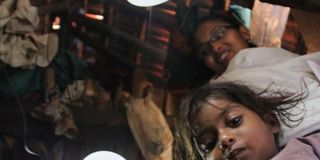Light up your home… with the power of gravity

Children use the lamp powered by gravity in India. PHOTO | SPARKNEWS
What you need to know:
- Using the force of gravity, the GravityLight is a safe alternative to kerosene for 1.3 billion people around the world who lack access to power
- The GravityLight goes beyond other user-powered products like the wind-up radio or pedal lights because of how quickly it generates energy.
Two industrial designers in London have discovered a clean, inexpensive way for people in developing countries to light their homes.
Using the force of gravity, the GravityLight is a safe alternative to kerosene for 1.3 billion people around the world who lack access to power.
It was the failure to fulfill one brief that set the creative wheels in motion for another.
The London-based product design consultants, Martin Riddiford and Jim Reeves, had been asked by the charity SolarAid to develop a light with a photovoltaic solar panel and battery at a cost of under $6 (Sh480).
The goal was to give people in the developing world an alternative to kerosene, which is expensive, toxic, dirty and dangerous.
After racking their brains, the industrial designers had to concede that they couldn’t fulfill the task.
LIGHTBULB MOMENT
Using solar energy after dark required storing it in battery form, making any product expensive and inefficient.
What was needed was energy that could be produced effortlessly and used instantly. And this is when the two men had their lightbulb moment.
“Realising that energy generated by gravity could replace expensive alternatives as an energy store was definitely one of those moments,” Reeves said. “The idea that something as simple as a bag of stones or dirt could be what produced the tension needed to generate kinetic energy was another.”
The GravityLight goes beyond other user-powered products like the wind-up radio or pedal lights because of how quickly it generates energy — a three-second lift of a bag gives up to 28 minutes of low light.
“Martin first proved the concept with a rig of bicycle wheels, chains, and a hand crank torch,” Reeves said.
Weighing just under a kilogramme, the GravityLight contains a few basic components: the main casing, looking like a mix between an egg timer and a fishing reel; the weight strap that feeds through the generator; and two bags with hooks to attach them.
When filled with sand or rocks, the bigger bag weighs in at around 10 kg (if overloaded, a red warning light comes on).
Once filled, the smaller bag attaches to the other end and works as a counterweight, sending the strap through a series of small gears that convert the kinetic energy into fuel for an LED light.
“It does make the slightest noise when in use,” said Reeves, “but it’s almost silent.”
Even while producing 0.1W of power, GravityLight can also run and recharge other devices such as torches and radios.
As recently as 2012, the future wasn’t looking too bright for the GravityLight’s inventors, who desperately needed funds to produce and distribute over 1,000 lights for field trials in Africa and India.
They wanted to know whether the light would survive the tough environments where it would have to function.
And they wondered if people would agree to get up every 20-odd minutes to lift up a bag.
The GravityLight is set to hit the market in 2015, with an initial price of around US $10 per unit in the developing world — a cost that Riddiford and Reeves are hoping to bring down with the profits from Western markets.
Among potential commercial partners, they are in talks with camping stores and supermarkets.




